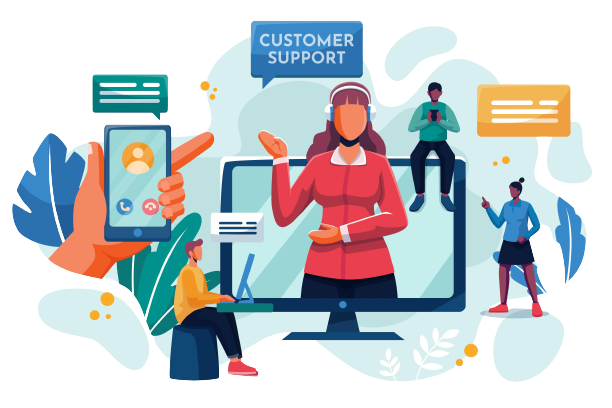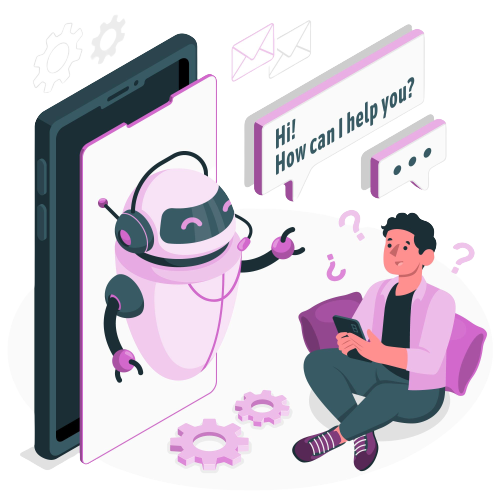
Keeping up with the latest trends in today’s business scenario is not just a smart move; it’s a must. Customer service has become a linchpin for businesses, and the tools we use to manage it are evolving rapidly. We’re in the age of putting customers first, and technology is the driving force behind it.
Customer service management software is going through a fascinating transformation. From smart chatbots powered by AI to making sure you can reach customers on any platform they prefer, and using data analytics for personalized experiences – there are exciting developments happening in this field.
In this blog, we’re going to discuss the most recent trends and innovations in customer service management software. We’ll break down the cool tools and strategies that not only make customer support better but also help businesses connect with their customers on a whole new level and, of course, boost their bottom line. So, let’s take a journey through this ever-evolving landscape, where each trend is a step towards delivering top-notch customer experiences.
Introduction to Customer Service Management Software Trends

Customer service management software is an integral part of modern businesses that strive to provide exceptional customer experiences. Staying updated in today’s dynamic business landscape with the latest trends in customer service management software is essential to meeting customer expectations and gaining a competitive edge. Let’s discover some of the prominent trends shaping the industry.
- AI-Powered Customer Service: Artificial Intelligence (AI) has transformed the way businesses interact with their customers. AI-driven chatbots and virtual assistants are becoming increasingly sophisticated, enabling them to handle routine customer inquiries and provide real-time assistance. These AI tools can swiftly respond to customer requests, allowing human agents to focus on more complex issues.
- Omnichannel Support: Customers now expect a seamless experience across various communication channels, including phone, email, chat, social media, and even SMS. Customer service management software is evolving to provide integrated omnichannel solutions. This enables businesses to offer consistent and personalized support, regardless of the channel customers choose to contact them through.
- Data-Driven Insights: Advanced analytics and data-driven decision-making are becoming central to customer service strategies. Modern customer service software platforms are equipped with robust analytics tools that help businesses gather and interpret customer data. These insights are invaluable for enhancing customer experiences, identifying areas for improvement, and making informed decisions.
- Mobile Accessibility: With the proliferation of smartphones and mobile devices, customer service management software is increasingly focusing on mobile-friendliness. Mobile apps and responsive web interfaces make it easier for customers to interact with businesses on the go, ensuring they can access support and information whenever and wherever they need it.
- Automation and Self-Service: Automation is being used to expedite routine tasks in customer service, such as routing tickets, categorizing inquiries, and suggesting relevant solutions. Self-service options, like knowledge bases and FAQs, empower customers to find answers to their questions independently. These trends enhance efficiency and customer satisfaction.
- Personalization: Customers appreciate personal touches in their interactions with businesses. Customer service management software is leveraging data to provide tailored experiences. From addressing customers by name to offering product recommendations based on past purchases, personalization is a key trend in enhancing customer relationships.
- Customer Feedback and Reputation Management: Gathering customer feedback and managing online reputation has gained significance. Advanced customer service management software allows businesses to proactively seek feedback, analyze it, and respond to reviews and ratings promptly. This trend helps build trust and maintain a positive online image.
Keeping abreast of these customer service management software trends is vital for businesses that aim to provide exceptional customer service. By adopting and adapting to these trends, companies can not only meet customer expectations but also streamline their support operations, boost customer satisfaction, and gain a competitive advantage in their respective industries. Let’s discuss these trends in detail.
Artificial Intelligence and Chatbots Revolutionizing Customer Support

In recent years, the incorporation of Artificial Intelligence (AI) and chatbots has completely transformed the landscape of customer support. This dynamic duo is a game-changer for businesses seeking to provide efficient and responsive assistance to their customers. Let’s find out how AI and chatbots are revolutionizing customer support.
- Enhanced Efficiency: AI-driven chatbots can instantly respond to customer inquiries, 24/7, without any need for human intervention. They can handle routine and frequently asked questions, freeing up human agents to deal with more complex issues. This not only reduces response times but also cuts operational costs.
- Personalized Experiences: AI systems have the capacity to analyze customer data, allowing chatbots to offer tailored recommendations and solutions. They can remember past interactions and use this information to create a personalized and engaging customer experience.
- Immediate Responses: Chatbots provide instant responses to customer inquiries, ensuring that customers don’t have to wait in lengthy queues or for office hours to get the help they need. This immediacy greatly enhances customer satisfaction.
- Scalability: Customer support demands can vary greatly, and AI-driven chatbots are highly scalable. They can manage hundreds of conversations simultaneously, which is essential for businesses experiencing spikes in customer inquiries.
- Language Support: Many AI-powered chatbots can communicate in multiple languages, making them invaluable for companies serving a global customer base. This feature eliminates language barriers, ensuring that customers from different parts of the world receive effective support.
- Problem Resolution: AI-driven chatbots are equipped to handle a wide range of customer problems, from troubleshooting technical issues to guiding users through account setup. They can even escalate issues to human agents when necessary, with a comprehensive history of the conversation.
- Cost Savings: By automating routine customer support tasks, businesses can significantly reduce labor costs. While chatbots handle repetitive queries, human agents can focus on complex problem-solving, leading to increased productivity and cost savings.
- Feedback and Learning: AI systems can collect and analyze customer feedback, enabling businesses to continuously improve their products, services, and support processes. This data-driven approach helps in making data-backed decisions to enhance the overall customer experience.
- 24/7 Availability: With AI and chatbots, customer support becomes accessible round the clock. This is particularly valuable for businesses serving customers in different time zones or those in need of assistance during non-traditional working hours.
- Predictive Analytics: AI can also help in predicting customer needs and issues. By analyzing data and patterns, chatbots can proactively offer solutions before customers even realize they have a problem. This level of anticipation can set a business apart in terms of service quality.
The integration of AI and chatbots into customer service management software is a powerful trend that is reshaping the way businesses interact with and support their customers. As the technology continues to evolve, it’s likely that AI and chatbots will become even more integral to the customer service landscape, providing businesses with a competitive edge in delivering exceptional support experiences.
Omnichannel Customer Service Solutions

Customers expect seamless and efficient service interactions across a variety of channels. Omnichannel customer service solutions are at the forefront of meeting these evolving expectations. Let’s dive deep into the concept of omnichannel customer service and its significance in modern customer service management software.
Understanding Omnichannel Customer Service
An omnichannel customer service is a strategic approach that ensures consistent, integrated, and synchronized customer support across all available communication channels. These channels may include traditional options like phone and email, as well as newer channels like social media, live chat, and messaging apps. The essence of omnichannel service is to provide a unified, cohesive experience for customers, regardless of how they choose to engage with your business.
Key Features and Benefits
Omnichannel solutions bring a range of features and benefits to the table, making them a crucial component of customer service management software:
- Seamless Customer Experience: With omnichannel solutions, customers can switch between different communication channels while receiving consistent and coherent support. For instance, they might start a conversation on live chat and continue it through email without losing context.
- Improved Efficiency: Agents have access to a consolidated view of customer interactions and data across all channels. This empowers them to respond more effectively and resolve issues quicker.
- Personalization: Omnichannel systems often include customer data integration, allowing for personalized service. Agents can view customer history and preferences, enabling them to tailor their responses.
- Real-Time Communication: Many omnichannel solutions offer real-time monitoring and reporting, providing businesses with valuable insights into customer behavior and needs as they happen.
- Reduced Customer Effort: Customers appreciate the convenience of omnichannel service, as it allows them to choose the most convenient communication method for their particular situation.
- Increased Customer Loyalty: Consistently positive experiences across channels lead to higher customer satisfaction and increased brand loyalty.
Challenges and Considerations
While omnichannel solutions offer numerous advantages, they also come with challenges:
- Integration Complexity: Integrating multiple communication channels and data sources can be complex and may require considerable effort to set up and maintain.
- Training: Agents need training to use the software effectively, as they must be proficient in handling various channels and maintaining a consistent customer experience.
- Data Security: Handling customer data across multiple channels requires robust security measures to protect sensitive information.
- Consistency Across Channels: Ensuring uniform quality and tone of communication across all channels can be challenging.
Selecting the Right Omnichannel Solution
When choosing an omnichannel customer service solution, it’s essential to consider your business’s specific needs and objectives. The best solution for your company should align with your industry, customer base, and communication channels. Additionally, you’ll want to evaluate the scalability, cost, and compatibility with your existing systems. However, adopting and implementing such solutions requires careful planning and consideration of the unique challenges and opportunities they present.
Data Analytics and Personalization in Customer Service

Data analytics and personalization have become pivotal components in delivering exceptional customer experiences. Let’s explore how these trends are shaping the way businesses interact with their customers and provide more tailored, efficient support.
Data Analytics: Unlocking Customer Insights
Data analytics in customer service management software enables businesses to collect, analyze, and leverage vast amounts of customer data. By examining this data, companies gain a deeper understanding of customer preferences, behavior, and pain points. Here’s how data analytics is transforming customer service:
- Predictive Analytics: By employing predictive analytics, businesses can anticipate customer needs and issues. This proactive approach allows for quicker problem resolution and personalized service.
- Performance Metrics: Customer service software with data analytics provides comprehensive insights into key performance metrics. This information enables businesses to identify areas for improvement, optimize processes, and assess the effectiveness of support teams.
- Segmentation: Data analytics allows companies to segment their customer base. This segmentation enables tailored communication and support strategies for different customer groups, ultimately improving customer satisfaction.
Personalization: Enhancing the Customer Experience
Personalization is no longer a novelty; it has become an expectation for customers. Customer service management software is at the forefront of delivering personalized experiences, which are proven to boost customer loyalty and engagement:
- Tailored Recommendations: By analyzing customer behavior and preferences, businesses can suggest products or services that align with the individual customer’s needs, increasing the likelihood of making a sale.
- Personalized Communication: Personalized email and messaging campaigns build stronger connections with customers. Personalization can go beyond simply addressing customers by their names; it can include customizing content and offers based on their past interactions.
- Support Preferences: Personalization extends to customer support. The software can remember the customer’s support channel preference, language, and the nature of past inquiries, allowing for more efficient and satisfying interactions.
- Proactive Outreach: Customer service software can trigger proactive outreach based on customer behavior, such as sending follow-up surveys after a purchase, offering assistance when a customer struggles on the website, or alerting customers about upcoming service renewals or promotions relevant to their history.
The Benefits of Data Analytics and Personalization
The integration of data analytics and personalization in customer service management software brings several significant benefits to businesses:
- Improved Efficiency: By harnessing data insights, businesses can allocate resources more effectively and reduce response times, leading to better overall efficiency.
- Enhanced Customer Satisfaction: Personalization demonstrates that businesses value their customers and are attentive to their needs, resulting in higher levels of customer satisfaction and loyalty.
- Increased Revenue: Customized recommendations and offers often lead to increased sales and a higher customer lifetime value.
- Competitive Advantage: Companies that leverage data analytics and personalization gain a competitive edge by delivering superior customer experiences and more efficient support.
Embracing these innovations can set businesses apart, creating stronger relationships with customers and driving growth and success.
Mobile-Friendly and Remote Support Tools: Enhancing Customer Service Accessibility

In our rapidly evolving digital landscape, mobile-friendly and remote support tools have become essential components of customer service management software. The demand for these features is driven by the increasing number of customers who prefer to interact with businesses on their mobile devices and the growing need for remote support options. Let’s explore how these tools are transforming the customer service landscape.
- Mobile Accessibility
With the proliferation of smartphones and tablets, customers expect the convenience of accessing customer service on their mobile devices. Mobile-friendly customer service management software ensures that users can easily navigate and use the system from the palm of their hands. This includes responsive design, intuitive mobile apps, and optimized web interfaces.
Mobile accessibility empowers both customers and support agents. Customers can initiate support requests, check order statuses, or engage in live chats with ease, regardless of their location. Support agents, on the other hand, can respond to inquiries, access customer information, and manage tickets while on the go, improving their responsiveness.
- Remote Support Capabilities
The ability to provide remote support is a game-changer in the world of customer service. Remote support tools enable customer service representatives to access and troubleshoot a customer’s device or software from a distance. This significantly enhances the efficiency of problem-solving, as issues can be resolved in real-time without requiring customers to visit a physical service center or allow technicians into their homes or offices.
These tools often include screen-sharing, remote desktop control, and diagnostic capabilities. With remote support, agents can guide customers through complex processes, software installations, or technical issues step-by-step, leading to quicker resolutions and higher customer satisfaction.
- Video Conferencing and Live Chat
Mobile-friendly and remote support tools also frequently incorporate video conferencing and live chat features. These technologies offer more personal and immediate communication channels. Video conferencing, in particular, enables face-to-face interactions between customers and support agents, fostering trust and humanizing the support experience, which can be especially important when dealing with complex or sensitive issues.
Live chat, when optimized for mobile devices, allows customers to engage in real-time text-based conversations with support agents, providing quick answers to their questions. It’s a versatile tool for resolving simple queries and escalating more complex issues as needed.
- Knowledge Base and Self-Help Resources
These tools aren’t just about agent-to-customer interactions. They can also empower customers to help themselves. Mobile-friendly customer service software often includes a user-friendly knowledge base accessible via mobile devices, where customers can find answers to common questions and troubleshoot issues on their own. This reduces the workload on support agents and provides customers with a convenient self-service option.
The integration of mobile-friendly and remote support tools in customer service management software enhances accessibility, convenience, and efficiency. By catering to the mobile preferences of modern customers and enabling remote support capabilities, businesses can provide superior customer service experiences that keep customers satisfied and loyal.
Automation and Self-Service Options in Customer Service Management Software
Automation and self-service options are becoming increasingly vital for businesses to efficiently meet the diverse needs and expectations of their customers. These two aspects of customer service management software have been trending and evolving in recent years, providing benefits for both businesses and consumers.
- Streamlining Routine Tasks with Automation:
Automation is the key to streamlining and optimizing routine customer service tasks. This technology allows businesses to set up predefined rules and workflows that can trigger actions automatically, such as sending follow-up emails, assigning tickets, or categorizing support requests. Some common examples of automation in customer service include:
- Automated Email Responses: Responding to common customer inquiries or confirming orders without human intervention.
- Chatbot Support: Implementing chatbots that can answer frequently asked questions and assist customers in real-time.
- Ticket Routing: Automatically directing support tickets to the appropriate department or agent.
- Scheduled Social Media Posts: Pre-scheduling social media updates for efficient communication.
By reducing the manual workload, automation frees up customer service agents to focus on more complex tasks and provide personalized assistance when needed.
- Empowering Customers with Self-Service Options:
Self-service options are all about providing customers with the tools and information they need to resolve issues independently, without having to contact customer support. This approach is beneficial for both businesses and customers in several ways:
- Knowledge Bases: Many customer service management software platforms offer knowledge base capabilities, allowing businesses to create extensive libraries of FAQs, articles, and guides.
- Community Forums: Encouraging customers to interact with each other, share experiences, and provide assistance on common issues.
- Interactive Troubleshooters: Offering step-by-step interactive guides to help users diagnose and resolve problems.
- User Portals: Allowing customers to track orders, manage subscriptions, or update personal information on their own.
The advantages of self-service options are clear: they reduce the workload on your support team, decrease customer response times, and provide an improved customer experience. Customers appreciate the convenience of finding answers at any time, while businesses save on support costs and increase efficiency.
- Combining Automation and Self-Service for a Comprehensive Solution:
The most effective customer service management software integrates automation and self-service features seamlessly. For instance, a customer may start a chat with a chatbot to inquire about their order status. If the chatbot can’t provide a complete answer, it can automatically escalate the conversation to a human agent.
This combination of automation and self-service ensures that customers receive quick and efficient assistance while allowing support teams to handle complex issues.
Customer Feedback and Reputation Management Integration
Customer feedback and reputation management play a pivotal role in shaping a business’s success. To stay ahead of the curve, companies are increasingly integrating customer feedback and reputation management into their customer service management software. This is not just a trend but a necessity to maintain a competitive edge and ensure customer satisfaction.
- Collecting Customer Feedback: Integrating customer feedback mechanisms within your customer service management software allows you to gather insights directly from your customers. This can be done through post-interaction surveys, feedback forms, or even by analyzing social media comments and reviews. The advantage of collecting feedback through the software is that it provides a structured and easily accessible repository of customer opinions.
- Analyzing Customer Feedback: Once you’ve collected customer feedback, the next crucial step is to analyze it effectively. Advanced algorithms and natural language processing (NLP) within modern customer service software can help categorize and prioritize feedback. This allows businesses to identify recurring issues, sentiment trends, and areas for improvement. It’s not just about listening to customers; it’s about understanding their needs and preferences.
- Reputation Management Integration: Your online reputation can make or break your business. Reputation management tools monitor online reviews, social media mentions, and other digital channels where your brand is discussed. Integrating reputation management with your customer service software lets you keep a close eye on your brand’s online presence.
- When a negative review or comment surfaces, your team can respond promptly, turning potential PR crises into opportunities to showcase your commitment to customer satisfaction. Positive feedback can also be leveraged to bolster your brand’s image further.
- Improving Service Quality: By combining customer feedback and reputation management, businesses can create a feedback loop that drives continuous improvement. For example, if customers consistently complain about a particular aspect of your service in feedback, you can use that information to make informed changes and then track how those adjustments affect your reputation.
- Enhanced Customer Engagement: Integrating customer feedback and reputation management into your customer service software encourages customer engagement. When customers see that their feedback is taken seriously, they are more likely to continue providing insights. It’s a proactive approach to address issues, show appreciation for positive feedback, and maintain a strong connection with your customer base.
- Building Trust and Credibility: With the growing importance of online reviews and customer testimonials, integrating reputation management can help you build trust and credibility with potential customers. Positive reviews and testimonials, strategically showcased, can become powerful marketing tools.
Final Thoughts!
The integration of customer feedback and reputation management into CRM management software is a significant advancement in the industry. It not only helps businesses identify and rectify issues promptly but also enhances customer engagement, trust, and loyalty. In a digital age where customers have a louder voice than ever, this integration is essential for any company looking to thrive in the highly competitive marketplace.